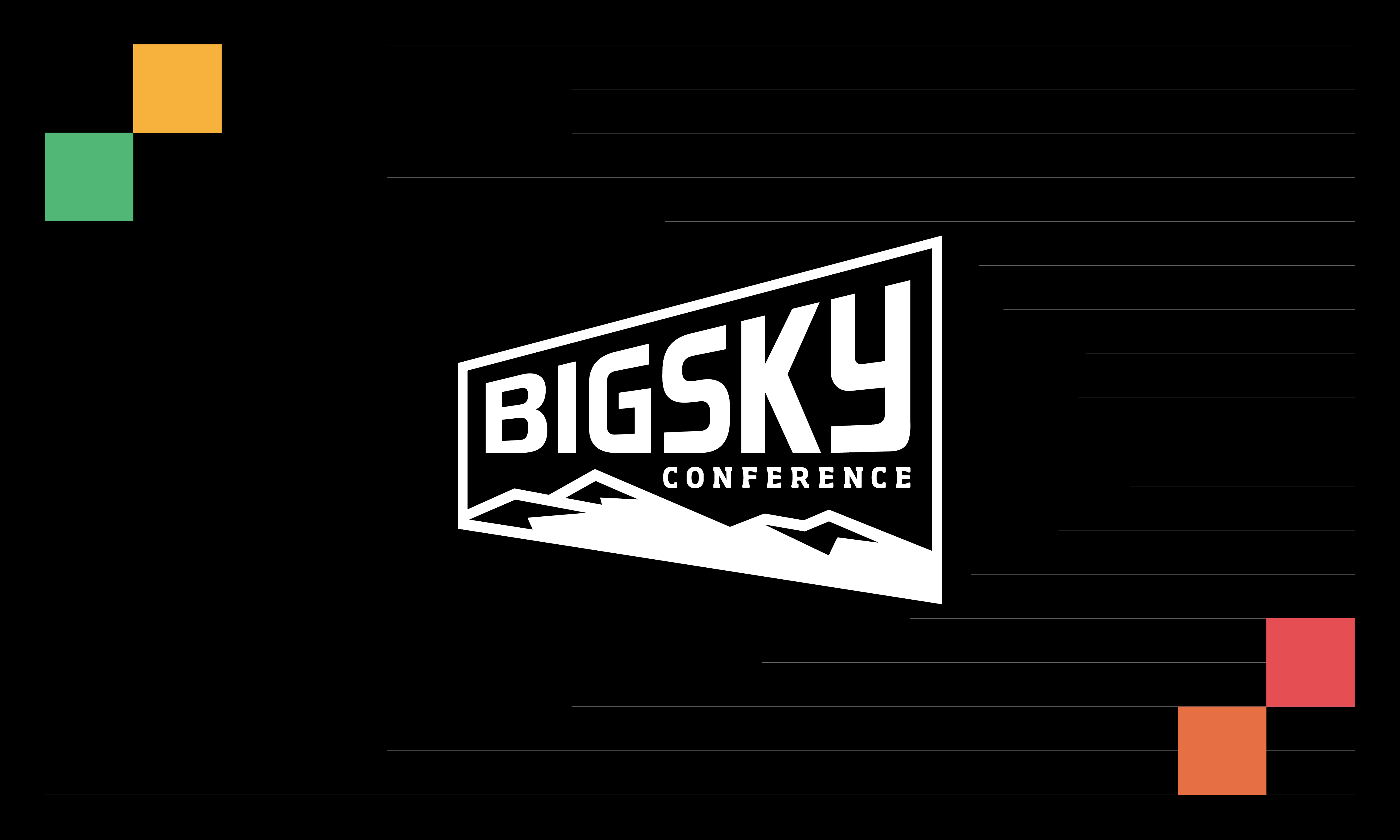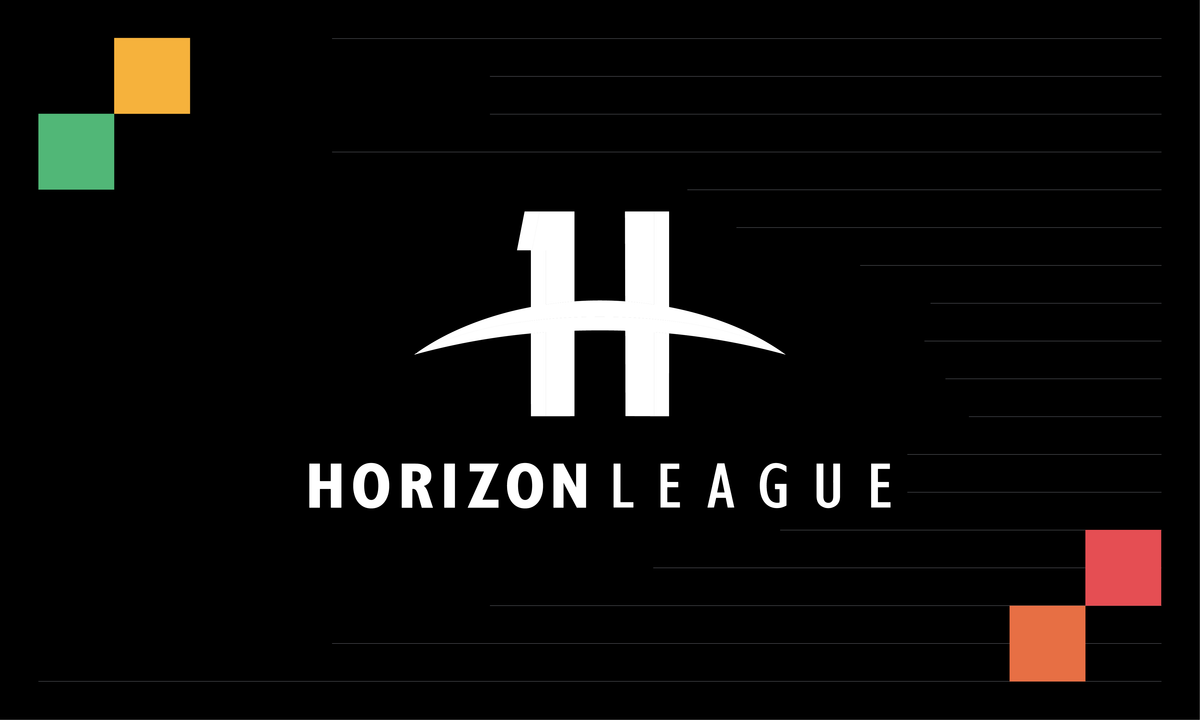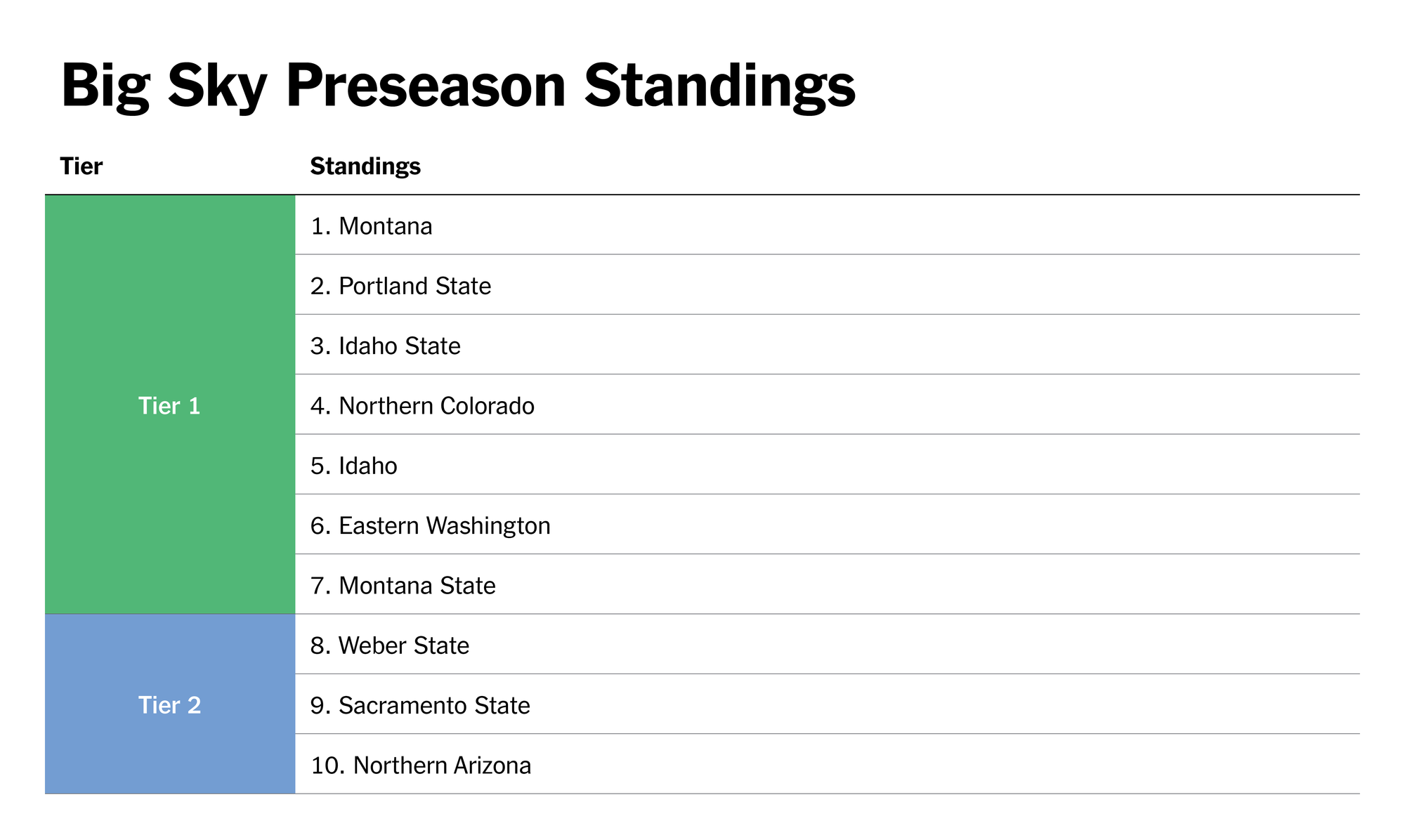
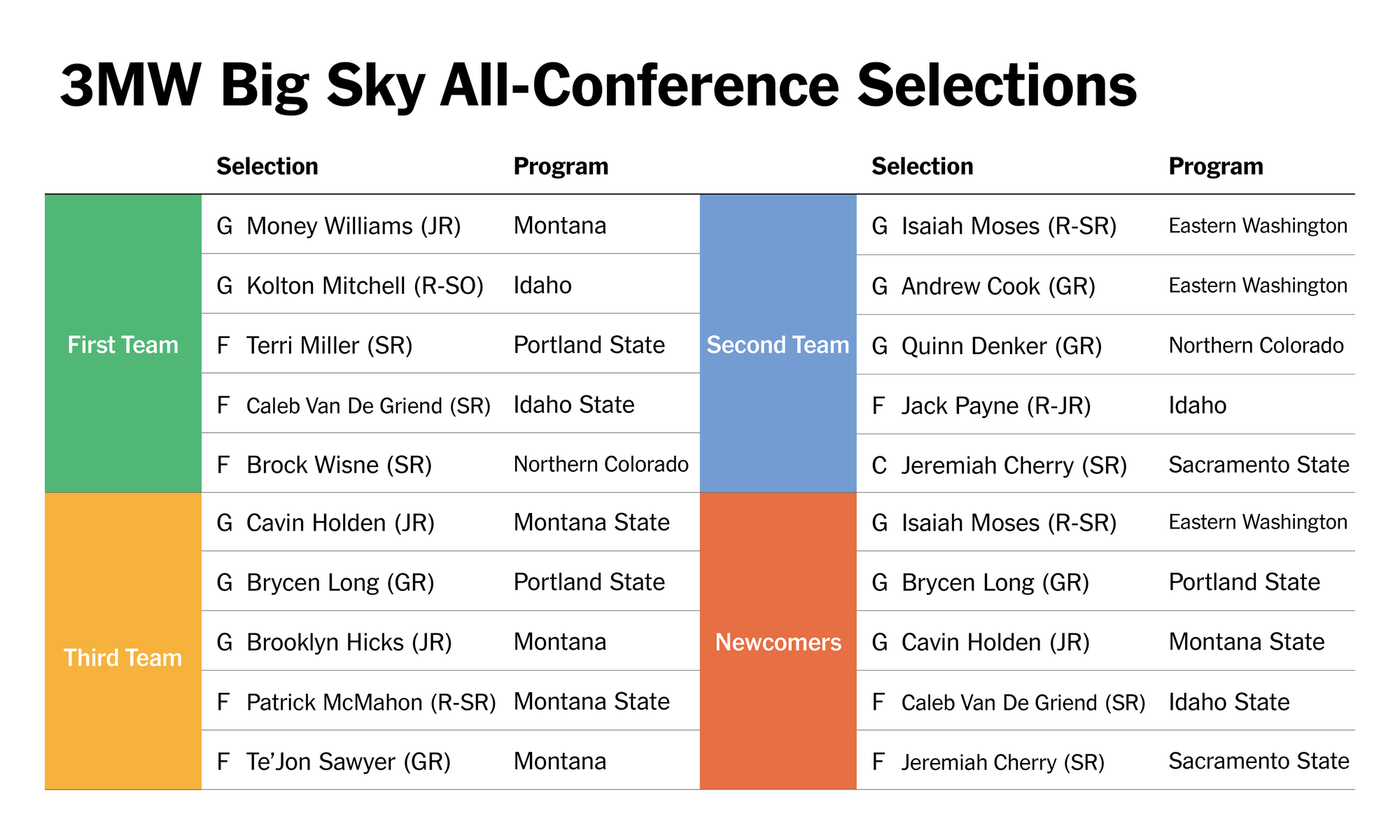
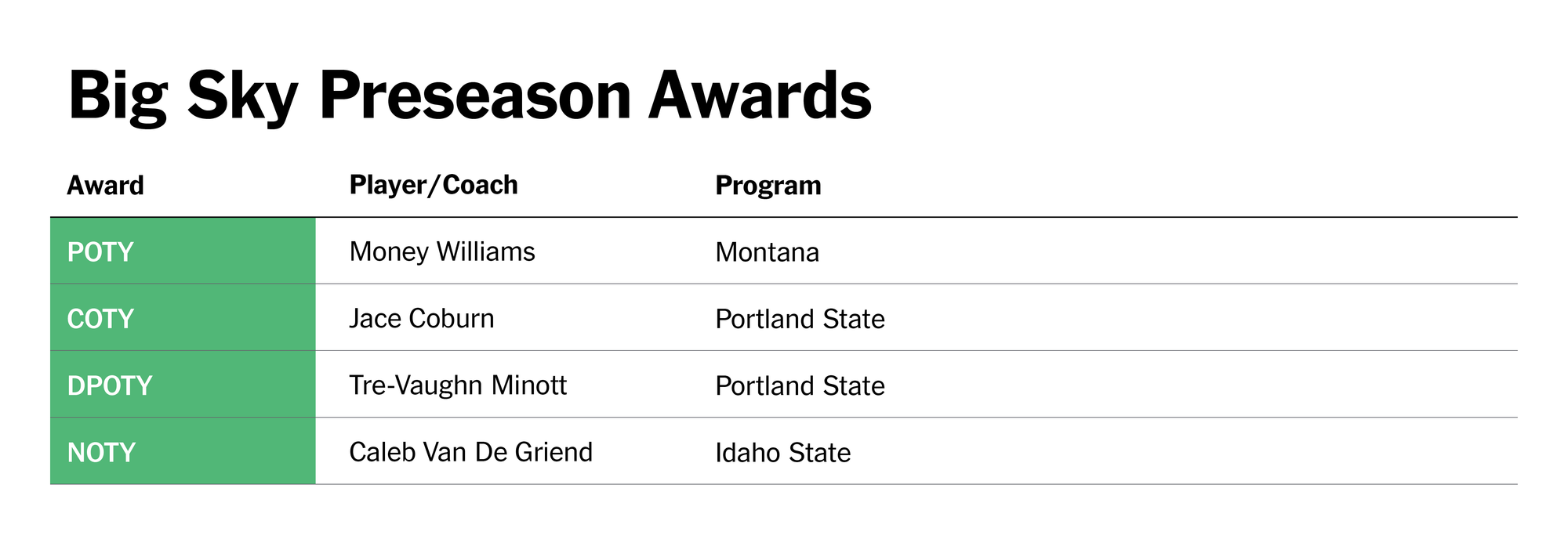
1) Montana
Key Returners:
Money Williams, Te’Jon Sawyer
Key Losses:
Malik Moore, Joe Pridgen, Kai Johnson, Brandon Whitney, Austin Patterson
Key Newcomers:
Brooklyn Hicks, Courtney Anderson, Kadyn Betts, Tyler Isaak, Grant Kepley, Trae Taylor
Roster:

Reasons for Optimism:
Here’s a start: Montana has Travis DeCuire, and the rest of the conference does not. After 11 years at Montana, he is firmly entrenched as a legend in the conference, having won 70% of his league games in that span. That included a 15-3 record and a Coach of the Year award last season, pushing the Griz into the NCAA Tournament for the third time in his tenure. He trails only Randy Rahe (former Weber State coach) and Mick Durham (former Montana State coach) in total wins as a Big Sky coach.
DeCuire gives Montana a chance every year. The Grizzlies’ roster pushes them towards favorite status this season, with two vital returning lineup bookends as the foundaiton: scoring guard Money Williams and versatile, burly forward Te’Jon Sawyer . Add in another deep and high-upside transfer core, and the Griz will be in the mix for DeCuire’s fifth Big Sky title.
Williams is the gunpowder that will ignite the Grizzlies’ offense this year. He is a big, physical guard that can get hot from deep (36% in Big Sky play) or barrel his way to the rim. He was up and down as a sophomore, resulting in him moving to the bench as a super sub in late January, but he had some nuclear scoring efforts that displayed his immense ceiling: an efficient 30 at Tennessee, 26 to win at Eastern Washington in the Big Sky opener, 59 combined in back-to-back games to start March. When he’s right, he is unstoppable in this league.
Sawyer is a less prominent part of the Grizzlies’ attack, but he remains important because of his scoring versatility. He is effective as a finisher or a roll man, and he also ranked in the 89th percentile in Spot Up efficiency, a massive help to Montana’s spacing.
With Sawyer likely continuing as a role player, DeCuire sought more impactful offensive pieces in the portal, particularly in the backcourt to support Williams. Coming off a superb redshirt freshman campaign, Grant Kepley is a tantalizing Division II addition. He can play point guard and move Williams off the ball, or he can happily subsist as a complementary scorer.
Montana also got a proven D1 performer in Brooklyn Hicks, though he desperately needs to find his jumper, and a high-upside swing in Courtney Anderson, who played in just four games over two seasons at Colorado. Both players hail from a higher conference and could excel under a coach who has been terrific at developing guards. JUCO transfer Tyler Isaak brings more wing size, and a redshirt year may have helped Chase Henderson after he struggled badly as a freshman in 2023-24.
That entire perimeter group will be part of a slash-and-kick offense that wants to spread the court with four or five skilled pieces to create driving lanes and open jumpers. In four of the last five years, Montana has ranked in the top 40 nationally in Spot Up frequency, per Synergy – the offense gets the shots it wants, especially with talented guards operating within it.
The Grizzlies’ defensive structure consistently helps them win games. They play a smart, conservative man-to-man shell, controlling the defensive glass and forcing opponents to score via individual excellence (post ups, isolation, pick-and-roll ball-handlers). The versatility of Sawyer and Minnesota transfer forward Kadyn Betts will allow the Griz to switch liberally, and Montana forces a steady diet of tough mid-range jumpers as a result.
Causes for Concerns:
A possible limiter to the Grizzlies’ ceiling is Williams’ efficiency, especially inside the arc. He was a poor finisher around the basket last year, with his downhill scoring relying on drawing contact to score efficiently. He was much better as a freshman, and his shot charts via CBB Analytics from each season display that difference. Bear in mind, though, that his rookie year encompassed just 12 appearances:
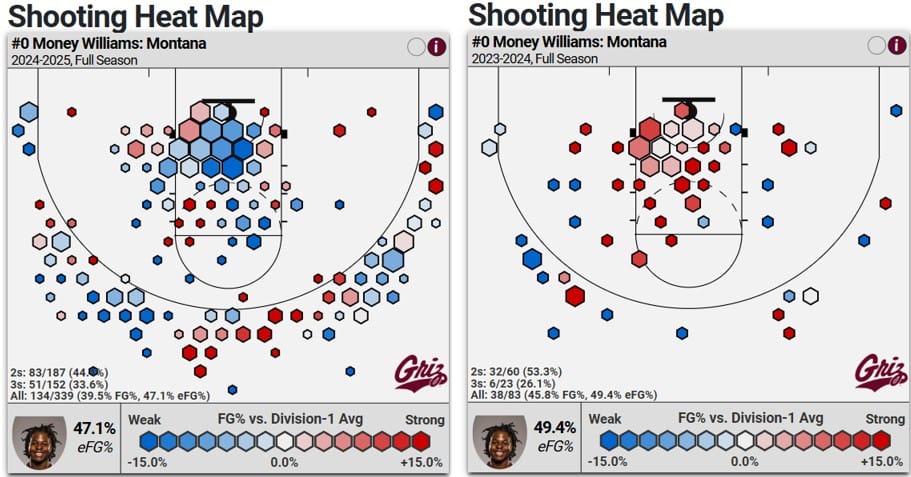
That wrecked his efficiency in ball screens in particular. He scored just 0.664 points per possession as a PnR handler, per Synergy, landing him in the 27th percentile nationally. Like the finishing, he was much better as a freshman (again, tiny sample), tallying 0.885 PPP (73rd percentile) in 2023-24. He needs to be closer to his freshman year self, which could be tough without the security blankets of Brandon Whitney, Malik Moore and Kai Johnson. If Williams remains erratic, Montana’s offensive ceiling will be slightly capped.
That ceiling can also be restricted at times by DeCuire’s overall approach towards the offensive glass. Montana’s best finish in offensive rebound rate in the last six years is 292nd, per KenPom, and the Griz landed 348th last year. Despite his frame, Sawyer is not a major presence on the glass, and Betts was not either in his limited minutes for the Gophers.
The spread, skill-based offensive system has some drawbacks defensively. Despite the ideal shot profile that DeCuire’s system forces opponents into, Montana has been below average overall on that end. Over the last four years, the Griz have ranked 251, 267, 250, 257 nationally in KenPom’s defensive rankings. Consistent? Yes. Good? No. The Griz went 15-3 in Big Sky play last year but still ranked just 6th in defensive efficiency.
They need Betts to be a contributor in the paint – a jumbo-sized Joe Pridgen, to give Montana fans a reference point. The interior depth is frightening if he does not find his footing down a level. Amari Jedkins lacks beef and did not do much with his small playing time allotment last year. Another Division II standout, Trae Taylor, adds an athletic finisher to the warchest, but even he was not an overly productive rebounder for Chico State. He did have some massive games down the stretch, so he could have an outsized impact in the paint; shooting 74% from the field is no joke at any level.
Bottom Line:
Montana has the best coach in the league, a potential star in the backcourt in Williams, and a rotational rock up front in Sawyer. The large collection of newcomers offers both upside and depth. The Grizzlies should be right in the mix to repeat as regular season conference champs.
A lot hinges on whether Williams is closer to his freshman season as a finisher and ball screen operator. If not, Kepley will shoulder a large ball-handling burden. The Grizzlies’ defense also seems to have a low ceiling while frequently playing smallball, despite an optimal structure in the shot diet it allows. Ultimately, I believe in DeCuire with a talented roster in this league.
2) Portland State
Key Returners:
Jaylin Henderson, Tre-Vaughn Minott, Terri Miller Jr., Kelcy Phipps
Key Losses:
Qiant Myers, Isaiah Johnson, Ismail Habib, Cole Farrell, Hayden Curtiss, Shane Nowell
Key Newcomers:
Brycen Long, Kean Webb, Isaiah Williams, Keyon Kensie, Mozae Downing-Rivers, Sebastian Tidor, Charles Chukwu
Roster:

Reasons for Optimism:
As long as Jase Coburn is in charge, no one should ever talk about Portland State without referencing his legendary introductory press conference. Breakfast and air conditioning are for chumps. He has endeavored to instill that identity in his players via his high-intensity system, and last year was the best version of it yet. The Vikings posted their first winning Big Sky record of Coburn’s tenure, and with three engines of that team back in the fold, hopes are high for another successful season.
The good vibes start with Terri Miller Jr., a massive bulldozer of a man who can take over games with his combination of size and skill. He really emerged over the second half of the season after forcing his way into the starting lineup. Coburn realized what he had and centered the offense around him, and Miller rewarded that faith:

Unsurprisingly, PSU was 14.5 points better per 100 possessions when Miller was on the court, per CBB Analytics (91st percentile nationally). Miller is an ambidextrous finisher around the bucket, often preferring to go to his left hand despite being a right-hander. He was excellent as a high-volume post threat, and he attacks the offensive glass with ferocity. The next step for him is improving his decision-making against the inevitable double-teams sent his way.
The Vikings have a nice inside-out combination with Miller and former Louisiana Tech teammate Jaylin Henderson, both of whom came to the Pacific Northwest last offseason. Henderson is a jack-of-all-trades who rarely left the floor, contributing most as a shooter and defender. He’s not an alpha, but he finds ways to contribute.
Both players should be comfortable in Coburn’s pressure defensive scheme. Per Synergy, PSU pressed on 13.1% of possessions, 69th nationally, and ranked 57th in forced turnover rate. The press number was actually the lowest of Coburn’s four-year tenure, as the Vikings lacked the depth of his previous iterations.
He hopes to have fixed that this offseason, bringing in numerous pieces that should be able to fill roles in his system. Mozae Downing-Rivers is a long, malleable defensive piece who fits the bill defensively, and athletic forward Keyon Kensie brings a similar kind of positional versatility. Both players needed the fresh start, as well, after struggling with inefficiency and injuries at their previous stops. Brayden Barron, on the other hand, is a local recruit who fits the player archetype that Coburn clearly craves as a 6-6 wing.
The gem of the newcomers could actually be Division II import Isaiah Williams. Yet another 6-6/6-7 type of piece, Wiliams averaged almost 3 stocks per game for Academy of Art (a solid program). His presence and activity level should translate seamlessly into the Vikings’ attacking mindset.
Under Coburn, PSU loves to play downhill on offense with a goal of getting as many near-proximity field goal attempts as possible. It is pretty clear where Coburn wants the Vikings’ bread to be buttered:
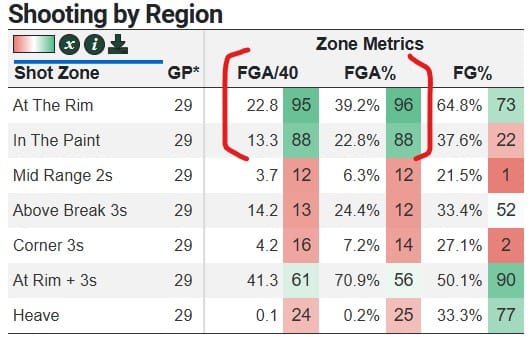
Miller and the athletic wings will lead the way there, but big man transfers Kean Webb and Charles Chukwu also fit the bill given their size.
Causes for Concerns:
PSU certainly did not retain every key piece. Long-armed point guard Qiant Myers is now out the door, and he was an enormous piece of PSU’s winning ways. He had elite court vision (certainly aided by his height), and his on/off impact was staggering. Per CBB Analytics, Myers had a net rating of +26.9, landing him in the 99th percentile nationally. Last year’s team had no alternative, and this roster only has some vague facsimiles of his game.
Junior college transfer Sebastian Tidor is probably the closest thing, as he’s a rangy guard who can create for others at times, as well. He trends far closer to scorer than playmaker, though, which is a major departure from Myers’ pass-first game. Kelcy Phipps was Myers’ backup last year, but he struggled badly as a freshman and would require a huge leap to become a winning player. Freshman Colt Ness has a chance to play; the Oregon native was a ballhawk on the football field and could fit comfortably into Coburn’s style.
Coburn also tried to find shooters. Other than Henderson, PSU was utterly bereft of volume threats from long-range threats, and even he was not a gravitational presence. That gave opponents the freedom to zone PSU without much worry, gumming up the paint and diffusing Coburn’s preferred offensive approach. The Vikings saw zone at a top 30 rate nationally, per Synergy, and scored just 0.843 points per possession against it (319th).
Tidor can knock down shots, but the real revolutionary addition could be Brycen Long. The former ASU Sun Devil and Houston Christian Husky can be lethal from distance; he drilled 94 triples at 41.6% for HCU back in 2022-23. He has only played six games in the last two years due to injury, but if he is healthy, he is a scoring dynamo with deep range.
Coburn has yet to have a top 200 offense at PSU, lagging far behind his defensive success. Three of his four offenses have ranked 289th or worse. He has tried different systems, with last year leaning harder into ball screens with Myers at the helm. No such creator exists, but Long, Miller and Tidor are three high-level scorers who could force the Vikings up the efficiency rankings through sheer force of ability.
Bottom Line:
Though Portland State has not ascended the Big Sky standings quite the way he would like, Coburn has definitely instilled his preferred identity with his teams. With a little more depth this year, expect a return to the full court pressure ways, and with more perimeter threats around Miller, the offense will have better spacing. Myers’ playmaking will be sorely missed, however.
PSU feels like a middle of the conference team in the preseason, but if Long is healthy and lights it up from deep, the Vikings have sneaky upside. No matter what happens, PSU will be a chore to play against based on the scrappy attitude that permeates from the coach.
3) Idaho St.
Key Returners:
Connor Hollenbeck, Evan Otten, Blake Daberkow
Key Losses:
Dylan Darling, Isaiah Griffin, Jake O’Neil, AJ Burgin, Jackson Greene
Key Newcomers:
Caleb Van De Griend, Gus Etchison, Lachlan Brewer, Jamison Guerra, Trey Arland, Quin Patterson
Roster:

Reasons for Optimism:
Ryan Looney won at the NAIA level: 97-53, made an Elite Eight. He won at the Division II level: combined record of 233-140, nine NCAAT appearances, including a national runner-up. Now, he might be starting to win at the Division I level, as well.
By multiple measures, ISU had its best season in a decade last year. The Bengals posted their highest win total since 2016 (both overall and in league play), and they had their highest KenPom final ranking since 2009. It took time, but Looney appears to finally have ISU headed the direction he wants.
Compared to Looney’s traditional style, it was a somewhat unconventional team. ISU ranked in the top 10 nationally in Post Up rate for four straight years from 2021-24, but they had no one capable of scoring inside last year, so the offense shifted. Of course, some of this shift was also a result of having Dylan Darling’s brilliance on the perimeter:
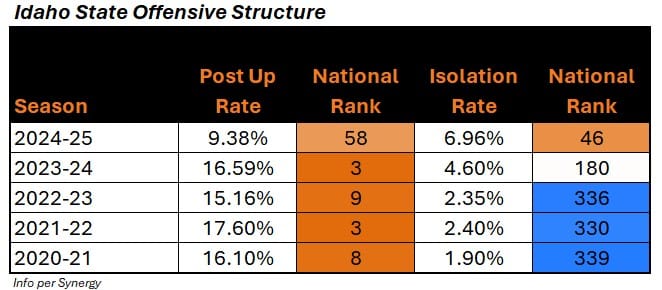
This roster does not have a Darling-esque megastar (few mid-major rosters ever do), but Looney did go out and reel in an elite post monster from the Division II level in Caleb Van De Griend.
At Minot State, Van De Griend basically ruined all statistical measurements with his ludicrous efficiency at high volume. Per CBB Analytics, he led all of Division II in Win Shares, WARP, and PER, and he ranked in the 98th percentile of the site’s own proprietary RAPM. Those all-in-one metrics show a ridiculously impactful player who should have little trouble finding his way in the Big Sky.
Van De Griend was completely unstoppable around the rim and on the glass. Some other wild statistical nuggets for him: he posted an offensive rebound rate of 18.7%, which led Division II and would have led Division I, as well. His 72.2% effective field goal percentage would have ranked second in Division I. Per Synergy, he ranked in the 87th percentile of Post-Up frequency, per Synergy, while scoring in the 98th percentile of efficiency. In Looney’s system, he could be the Big Sky Player of the Year.
Van De Griend is a steady but unspectacular defensive player, so having Evan Otten around to police the paint will be vital. As a freshman, Otten was a menace around the bucket, leading the Big Sky and ranking 10th nationally in block rate (KenPom). He is strictly a rebounder/finisher on offense, but next to Van De Griend, that is fine. The frontcourt rotation is tied together by Connor Hollenbeck, a skilled shooter who can help space the floor around the Bengals’ two true big men. Plus, there’s some depth with Blake Daberkow and athletic ‘tweener Cheikh Sow.
Otten and Sow should provide an imposing defensive foundation, typically a steady area under Looney. The Bengals should be outstanding on the glass with Otten and Van De Griend around, and this could be an extremely imposing interior defense. ISU needs to find some tighter defense (and beneficial regression) on the perimeter, though, as foes have buried 37.3% (344th) and 36.0% (318th) from beyond the arc the last two years.
Causes for Concerns:
The burning question of Idaho State’s offseason: how much of Idaho State’s ascension last year was due simply to the atomic explosion experienced by Darling? The Bengals’ point guard was utterly unstoppable in league play, racking up 23.2ppg, 5.9apg and 1.9spg in 36.8mpg on 47.2%/38.9%/81.1% shooting splits. That’s quite good!
He was completely unguardable, cooking players off the bounce and forcing constant double- and triple-teams. He scored in the 83rd percentile in isolation while landing in the 100th percentile of frequency, per Synergy. He also ranked in the 82nd percentile in efficiency on ball screens while also in the 82nd percentile in frequency. CBB Analytics had him as a +14.8 net rating, the best on the Idaho State roster and in the 91st percentile nationally. He was a one-man wrecking crew in the truest sense of the phrase.
This year’s guards will have a far smaller burden thanks to Van De Griend’s arrival, but with the primary creators coming from NAIA – pure PG Jamison Guerra and prolific scoring combo guard Gus Etchison – the perimeter playmaking is still a question mark.
That duo, along with the rest of the Bengals’ perimeter rotation, will be tasked with improving the spacing in Pocatello. Per Shot Quality, ISU ranked 318th in that category last year. Having such a heliocentric offense based on Darling’s talents gave foes a chance to sag into gaps, and outside of Hollenbeck, ISU struggled badly to punish those helpers.
Unsurprisingly based on their styles, Etchison is a bomber, while Guerra is more of a “knock it down if they leave me open” type. In 29 games at Marian, Etchison cashed in 73 triples on 214 attempts, while Guerra only attempted 80 3s last year. The Bengals will need more spacing and scoring from Lachlan Brewer, an intraconference transfer who filled a similar “stand and shoot” role at Sacramento State, and Trey Arland, a big-time scoring wing at the JUCO level. A wild card is Quin Patterson, who comes from a great program (UCSD) but has yet to really contribute at the college level.
Bottom Line:
Yes, he is from Division II, but there’s a very real chance Van De Griend is the best interior player in the conference. If he is the best player overall, no qualifier, then Looney and the Bengals could leapfrog even last year’s squad in their ascent up the Big Sky. That marriage of player and coach is as strong a pairing as you’ll find in this conference.
The downside, though, is if ISU cannot get Van De Griend the ball enough (lack of true dynamism on the perimeter without Darling) or in places for quality looks (continued lack of spacing). The guard group is alarmingly green, and the Bengals’ overall shooting may be just as pedestrian as last year if Etchison has any struggles. ISU has a fairly wide range of outcomes.
4) Northern Colorado
Key Returners:
Zach Bloch, Quinn Denker, Brock Wisne
Key Losses:
Langston Reynolds, Isaiah Hawthorne, Jaron Rillie, Marcell McCreary
Key Newcomers:
Vincent Delano, Ibu Yamazaki, Ring Nyeri, Kaden Ericksen, Chancellor White
Roster:

Reasons for Optimism:
Long an afficionado of an analytical approach to basketball and a wise user of the portal, Steve Smiley finally had his breakout campaign in the sideline last year. After four years just outside the KenPom top 200, Smiley’s Bears broke through for 25 wins (15-3 in the Big Sky) and a 126 finish in Mr. Pomeroy’s standings. Unsurprisingly, an efficient offense and several key portal pieces led the way.
With some key departures (four of the Bears’ top five scorers), Smiley once again had to work his portal magic. His development will also be tested, but his track record there is sublime, consistently turning JUCO guys (Dalton Knecht) and castoffs (Isaiah Hawthorne, Saint Thomas) into all-conference studs.
On the bright side, three key rotation pieces did return. Brock Wisne is the most important, the Bears’ lone truly effective big man last year that is a force on the block and the offensive glass. In some part due to UNC’s lack of a quality backup, Wisne posted the best Net Rating on the team per CBB Analytics (+10.0), and his presence as a smart veteran center made a world of difference defensively. He also was the biggest reason the Bears’ shot chart was a fireball near the rim:
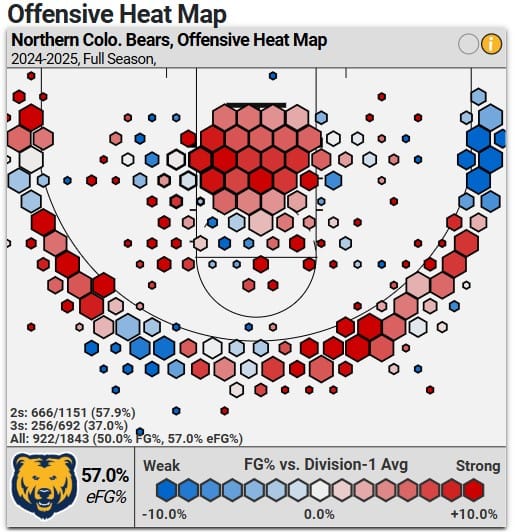
Wisne himself shot 70.8% at the bucket, and he’ll be a clear fulcrum again this season.
The Bears also brought back wings Zach Bloch and Quinn Denker, both positive contributors to last year’s immense success. Despite low usage, Bloch is an offensive weapon due to his shooting stroke. He slumped a bit last season on catch-and-shoots, but he ranked in the 88th percentile in Off Screen frequency and the 99th percentile of efficiency, per Synergy. His movement requires defensive attention. Denker is more of a combo type, capable of hitting shots but also bringing some secondary playmaking. When Bloch, Denker and Wisne all shared the court, UNC was +20.2 points per 100 possessions, an elite figure.
Smiley snagged a similar archetype to Denker in JUCO addition Kaden Ericksen, a do-it-all type who can complement Bloch and Denker off the bench.
Denker and Ericksen’s creation will be more important without Jaron Rillie and Langston Reynolds, who combined to average 8.0apg. Their absence clears the runway for transfer PG Vincent Delano to take off in Smiley’s system. He had the typical rookie struggles as a lead guard – perhaps even more exaggerated for a terrible Portland team – but he’s the type of buy-low talent with which Smiley has hit home run after home run.
Speaking of which: Thomas and Hawthorne were both versatile mismatch forwards who could step out and knock down shots. Smiley picked up three players with the potential to deliver in that role. Ibu Yamazaki was a hyper-efficient complementary scorer at Radford, stretching the court and shooting a lethal 78.8% at the rim per CBB Analytics. Ring Nyeri filled an almost identical role at Kansas City. Both players will give Wisne a ton of room to operate near the basket.
The third option, Chancellor White, is a wild card. He was much higher-usage than Yamazaki or Nyeri, but he was inefficient and on a terrible team. He’ll need all of Smiley’s magic dust.
Causes for Concerns:
As good as Wisne is, the Bears were highly pedestrian when he left the court, and the big man rotation is thin once again. Egan Shields was somehow invisible on the defensive glass despite being 6-10, 250 pounds, and William Humer could not crack the rotation for a team that really needed another big body.
The best hope to avoid a major drop-off when Wisne sits is for Shields to progress as a sophomore, and in his defense, he did flash as a finisher inside. Getting some impact from Hunter Caldwell is more of a long shot, as the Colorado native redshirted last year to develop his skill and frame. At minimum, the three different 6-10 options provide Smiley hope of finding some bench stability.
Any of that trio offering some defensive resistance would be a welcome sight. Northern Colorado has struggled on that end under Smiley, as his focus on skill in both the recruiting and development phases has left the Bears short of serious stoppers. The imbalance is perfectly demonstrated via KenPom’s rankings:
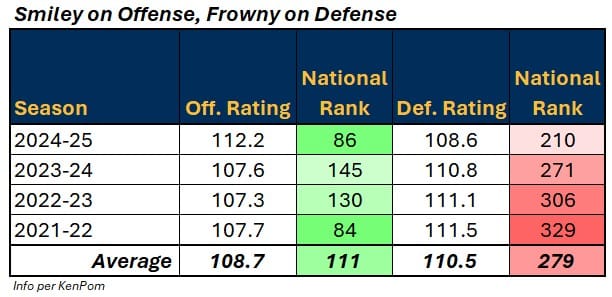
The Bears were actually solid on defense within the Big Sky (3rd in efficiency, per KenPom), but the clear tilt to one direction overall is an alarming trend – particularly with another roster seemingly devoid of lockdown individual defenders.
The scheme is the scheme: conservative in mostly drop coverage, refuse to help off shooters, force the ball-handler to score and take tough 2s, dominate the glass. As part of that refusal to help much, UNC gave up the highest frequency of Post Up possessions in the country, per Synergy. The Bears generally struggled to defend those, as even Wisne is not a blanketing big man. Still, that’s part of Smiley’s calculation: encourage tough post ups, take away efficient spot up opportunities.
The Bears have to avoid plummeting back down the national ranks defensively after climbing to 210th last year. They still have no shot-blocking, and they again will not force many turnovers. They do not mix in zone either. Teams are simply too comfortable, and that could lead to a dip back down this year without Hawthrone and Marcell McCreary.
Bottom Line:
Smiley has earned a sparkling reputation as an identifier of undervalued offensive talent (and a subsequent developer of that talent). He will need to cash in on that ability again this year, as the Bears need Delano to take a major leap in a new context as a sophomore. Fortunately, Wisne is a rock inside, and the Bloch/Denker wing duo will provide spacing and secondary playmaking.
The Bears’ gains on defense last year allowed them to finally ascend to the Big Sky’s pinnacle. Staying in that stratosphere will be a challenge with what appears to be a less athletic roster, and players like White and Nyeri need to emerge after tiny roles at other mid-major programs. Still, Smiley and the veteran core is enough to keep UNC in the top half of the league – with upside for more.
5) Idaho
Key Returners:
Kolton Mitchell, Jack Payne, Kristian Gonzalez, Tyler Linhardt, Trevon Blassingame, Isaiah Brickner, Titus Yearout
Key Losses:
Tyler Mrus, Julius Mims, Kyson Rose
Key Newcomers:
Brody Rowbury, Biko Johnson, Seth Joba
Roster:
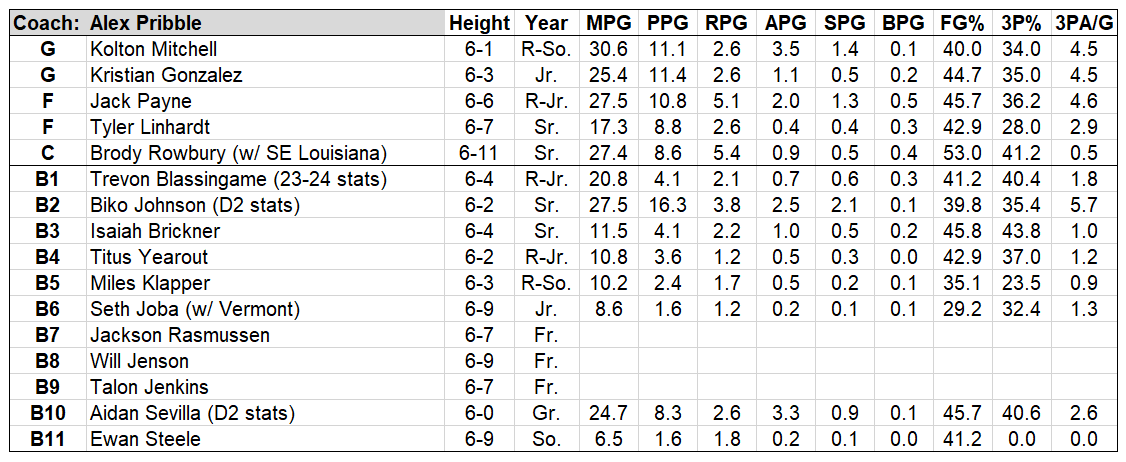
Reasons for Optimism:
After six years finishing 300 or worse in KenPom, Idaho finally clawed back towards respectability last year. Alex Pribble’s second year in charge saw a 40-spot improvement at KenPom and the most conference wins (eight) for the Vandals since 2018. It is surely not quite where Pribble wants to be – 14-19 overall does not feel like a heroic year – but moving in the right direction definitely matters.
The optimism should abound this year, as Idaho boasts some of the best continuity in the country. The Vandals return eight guys who averaged 10+ minutes per game in their most recent Idaho season, and per Bart Torvik, they bring back 62.7% of their minutes. That’s good for 17th nationally, and six of he teams ahead of them are Ivy/Patriot, which are playing a different game.
A deep backcourt with a bevy of ball-handling and creation headlines the Idaho excitement, highlighted by returning trio of double-digit scorers. Kolton Mitchell has the most star upside after starting every game as a redshirt freshman, showing off steady playmaking instincts and a promising perimeter stroke. Plus, he’s an Idaho native who transferred from Idaho State, fueling a great rivalry fire. Jack Payne is a point wing of sorts, capable of hitting shots or targeting smaller/slower defenders with his ball skills. And Kristian Gonzalez was the most efficient scorer of the bunch.
Ultimately, though, Mitchell is the straw that stirs the drink. He led the Vandals in pick-and-rolls run, including pass-outs (345 to Payne’s 100) and isolations (41 to scoring forward Tyler Linhardt’s 35).
Pribble emphasizes a democratic approach to playmaking, spreading the floor and attacking with ball screens or simple one-on-one to set up a slash-and-kick flow. The Vandals ranked 5th nationally in Spot Up frequency last season, per Synergy, and they ranked a solid 91st in Shot Quality’s spacing metric as a result. Adding two more perimeter weapons to an already-deep group should reinforce that strategy.
Biko Johnson is the external hire, a former Division II scorer who can bomb away from deep but also brings the requisite passing to the table. Even with a crowd of returners, he could push for a starting gig, especially if Payne slides to a smallball 4 role. The Vandals also get Trevon Blassingame back from injury, a taller complementary threat who makes more of an impact defensively. Add that to Isaiah Brickner, another defensive menace, and Titus Yearout, a guard version of a “know your role” all-star, and Idaho probably has the deepest backcourt in the conference.
That will allow Pribble’s spread onslaught to continue, though he also has a new device in his toolbox. That would be the enormous Brody Rowbury, a 6-11, 255-pound behemoth who is returning home to Idaho. He is a true bulldozer inside, gobbling up offensive rebounds and generally proving to be unguardable on the block (1.163 points per post up possession, 93rd percentile nationally). He posted the 4th-best offensive rating in the entire Southland, albeit on lower usage.
Idaho may not feed him on the block frequently; that’s really not Pribble’s MO. Still, adding a new kind of weapon to what was already the #4 offense in the Big Sky, to go with internal development, gives the Vandals a chance to score at will.
Causes for Concerns:
The Idaho Issue is that a basketball court has two ends to it. Specifically, you are tasked with not just scoring on one of the buckets, but also defending the other end. And Idaho…did not really do that last year. The Vandals ranked 345th in the country and dead last in the Big Sky in KenPom’s defensive efficiency, getting torched at the rim while also giving up copious offensive rebounds and rarely forcing turnovers. It is a defensive formula form hell.
As skilled as the Vandals’ perimeter group is, they are all fairly weak defensively, getting cooked off the bounce and struggling against true athleticism. Mitchell and Gonzalez are both slight of figure, and though Payne brings a physical mean streak, he also has some physical shortcomings. The same goes for Linhardt. More minutes for Brickner could help, as will the return of Blassingame. Johnson was a defensive demon at Fort Lewis, another reason he could end up pushing the incumbents for big minutes.
The addition of Rowbury is a mixed bag on this end. On the plus side, he’s a mountain of a man who should help Idaho’s interior defense despite not being a shot blocker. Unfortunately, though, he’s pretty slow-footed and can get flambeed by anyone with a pulse off the bounce. Idaho will have to play deep drop coverage when he’s on the court, opening up scoring chances for opposing guards.
The rest of the frontcourt rotation is highly suspect. Seth Joba was a major disappointment at Vermont, and even a drastic change of environment may not revive him. Ewan Steele is still developing. And the freshmen, Will Jenson and Jackson Rasmussen, won’t be defensive difference-makers. Rasmussen, at least, has a chance to earn minutes with his smooth offensive game. Idaho could end up playing some tiny five-out groups with Payne/Rasmussen and Linhardt as the 4 and 5, hellbent on trying to outscore opponents.
Bottom Line:
The Vandals are a pretty clear split. The offense is loaded thanks to a roster flush with skilled guards and bigger playmakers, and the newest addition in the paint (Rowbury) brings an added interior scoring dimension. Mitchell and Payne are going to be a handful, and having so much perimeter depth means the Vandals can push the pace.
Unfortunately, I have no idea how Idaho gets stops. Even with Blassingame back and Johnson joining the fold, the athleticism is sorely lacking, and the added size up front is nowhere near a fix for the multitudes that ailed this defense. That probably caps the Vandals ceiling, even if the efficient attack makes a dark horse push for KenPom’s top 100. Idaho Vandals, YOU are a lopsided lovely.
6) Eastern Washington
Key Returners:
Andrew Cook, Emmett Marquardt, Tyler Powell, Elijah Thomas
Key Losses:
Mason Williams, Nic McClain, Sebastian Hartmann, Vice Zanki
Key Newcomers:
Isaiah Moses, Kiree Huie, Johnny Radford, Jojo Anderson, Straton Rogers, Alton Hamilton IV
Roster:
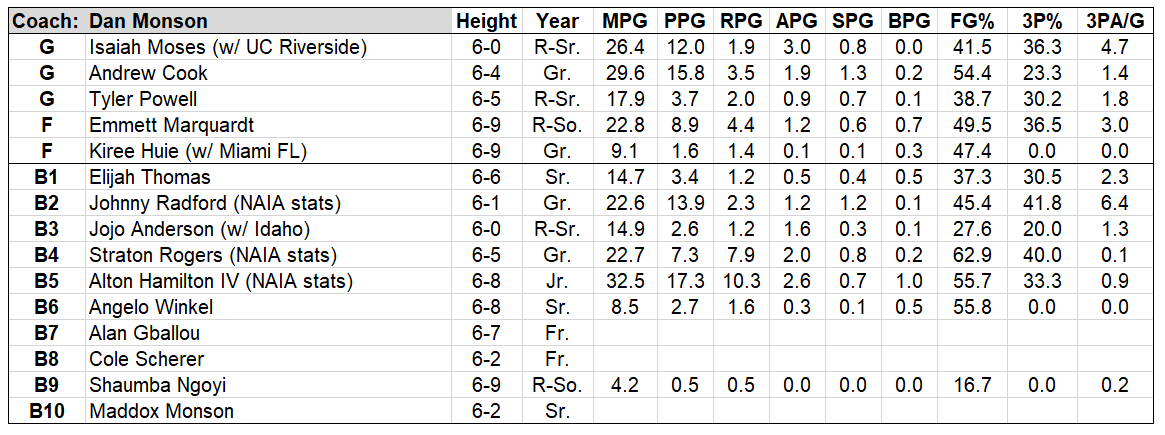
Reasons for Optimism:
Last year’s debut was not a Dan Monson season. The grizzled veteran coach had a long run of success at Long Beach State, so kicking off his Eastern Washington tenure with the school’s worst year since 2013 is hardly what he or the administration had in mind. But he may not stay down for long.
His first year at LBSU (6-25 overall, 3-13 in conference, 304th in KenPom) was eerily reminiscent of his EWU debut (10-22, 6-12, 295th). He quickly turned the 49ers’ fortunes, drastically improving their record (15-15 overall, 10-6 in league) and analytical ranking (168th). That began LBSU’s period of prosperity, and EWU will hope for something similar beginning in 2025-26.
The Eagles were a massive beneficiary of the Pavia Rule that awarded an extra year of eligibility to players who completed seasons outside the purview of the NCAA. Thanks to that change, Andrew Cook, a former NAIA transfer, returns as the Eagles’ alpha offensive weapon. He’s not a long-range gunner, but he is highly effective from everywhere else on the court:
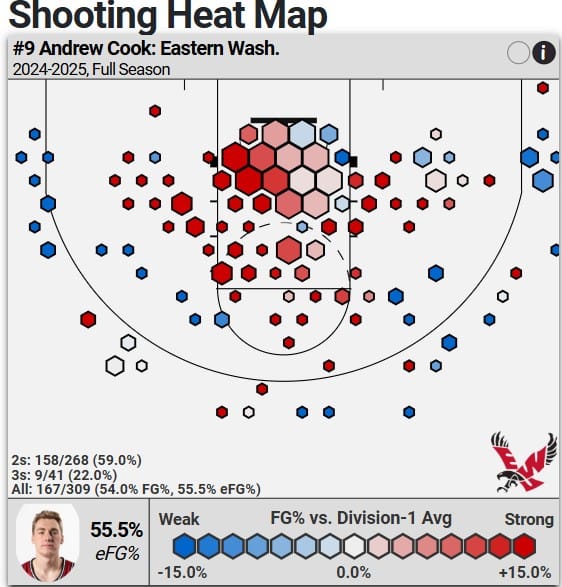
Monson got him the ball in myriad ways, and Cook was efficient in all of them: transition, ball screens, posting up mismatches, cutting off the ball. The Eagles’ offense was +13.9 points per 100 when he played vs. when he sat, per CBB Analytics.
That narrowly edged the offensive impact of Emmett Marquardt, who was +13.8 in the same measure. The versatile big man was a hugely positive player as a rookie thanks to his ability to attack the glass, knock down perimeter shots and finish around the rim. He is the perfect complementary threat to Cook’s on-ball prowess, and he could develop into even more in year two.
Monson’s newcomer haul could have a huge impact on winning. Isaiah Moses shared lead guard duties on some of the best teams UC Riverside has ever had, including the school’s first two 20+ win seasons in its Division I history. Now out of Barrington Hargress’ shadow, the elusive Moses could shine. He will also help ease the turnover issues that stemmed from his predecessor, Nic McClain. EWU also added a high-upside rookie guard in Cole Sherer, an incendiary scorer who adds another potential creator with Moses and Cook.
Following Cook’s success, Monson delved back into the NAIA level for two ultimate winners in Johnny Radford, a big-time sniper with deep range, and Straton Rogers, a gritty stat-stuffing ‘tweener forward. Both were key members of College of Idaho’s 35-2 national champion squad. Add in Alton Hamilton IV, a double-double machine for NAIA Lewis-Clark State, and that level has given EWU four potentially vital pieces this season.
Another transfer, Kiree Huie, did not accumulate gaudy stats last year, and he played for a complete disaster of a power conference team at Miami. But Huie has been a major contributor in the Big Sky before, having racked up an efficient 11 points, six rebounds and a block per game at Idaho State back in 2023-24. He solidifies a rotation that was lacking with Angelo Winkel and Shaumba Ngoyi forced into duty.
Monson frequently fed his big men on the block while at LBSU, but last year’s Eagles totally lacked that kind of threat. In Huie and Hamilton, EWU now has two actual targets on the interior. Huie ranked in the 99th percentile of post up frequency back at ISU, per Synergy, and scored respectably (68th percentile in PPP). Hamilton similarly landed in the 99th percentile in frequency last season, pairing that with the 77th percentile in efficiency.
Causes for Concerns:
Eastern Washington was not just run-of-the-mill bad. The Eagles faceplanted compared to expectations, consistently underperforming as they failed to match strong early performances against Seattle and Missouri. The Eagles eventually limped to a 7-22-1 record against the spread, the worst mark in the entire country. Only Columbia, in five fewer lined games, managed as few as seven ATS victories, and the Lions did so in five fewer lined games.
The defense was a major culprit. EWU struggled badly go get stops if it did not force a miscue, ranking outside the top 300 in every Four Factor except turnover rate. For all of Cook’s immense offensive skill, he was an outright poor defender, and fellow returners Tyler Powell and Elijah Thomas moved the needle in the wrong direction as well.
The Eagles frequently over-extended themselves, and that resulted in surrendering far too many layups and second shot opportunities. Opponents took 36% of their field goal attempts at the rim last season, per CBB Analytics, which placed Eastern Washington’s defense in the 10th percentile of frequency allowed (more = bad). EWU also landed 332nd nationally in defensive rebound rate (dead last in the Big Sky).
Adding Huie will help both of these issues to an extent, as will Rogers, a defensive menace. But they may still remain fundamental flaws in the defensive structure. The perimeter players have to find a way to balance their aggression for steals with keeping players in front – and avoid fouling. EWU was also dead last in the Big Sky in free throw rate allowed (327th nationally). In 17 years at LBSU, Monson’s teams never ranked worse than 257th in that category.
Both Powell and Thomas are likely to net some minutes again this season, as is Idaho transfer Jojo Anderson. All three were emphatically negative players in the Big Sky last season, so it would take some major progress from each to suddenly help push the Eagles up the standings. Per EvanMiya, out of 93 players who logged at least 300 possessions, they ranked as the #54 (Powell), #80 (Anderson) and #85 (Thomas) players in the conference. If the NAIA transfers do not work out, EWU is going to be alarmingly thin after the Moses-Cook-Marquardt trio.
Bottom Line:
Eastern Washington flashed upside last year, particularly via Cook and Marquardt on the offensive side of the ball. The defense lagged behind, though, and the Eagles’ consistency in falling short of analytical expectations paints a gruesome picture of Monson’s first year in Cheney.
Hope springs eternal, though, as the return of those two efficient offensive players plus a promising transfer influx could ease some of EWU’s issues. Huie and Hamilton are terrific fits in Monson’s offense, Moses is likely an upgrade at point guard, and the NAIA champion duo of Stanford and Rogers brings winning DNA. Expect the Eagles to be far more competitive on a night-to-night basis.
7) Montana St.
Key Returners:
Patrick McMahon, Jed Miller
Key Losses:
Brandon Walker, Max Agbonkpolo, Jabe Mullins, Tyler Patterson, Bryce Zephir, Sam Lecholat, Brian Goracke
Key Newcomers:
Christian King, Cavin Holden, Davian Brown, Chris Hodges, Waka Mbatch, Howie Keene, Seth Amunrud
Roster:

Reasons for Optimism:
Two years into his Division I tenure, Matt Logie has a very Jeff Fisher-esque hue to his Big Sky record. Back-to-back 9-9 years in league play paint quite a middling picture. Though Logie’s Bobcats did win the Big Sky Tournament in 2024, they have not carried on the dominance of Danny Sprinkle’s final two campaigns in Bozeman. Of course, Sprinkle himself was middling his first two years at MSU, so this could be Logie’s breakout campaign.
Crucially, the Bobcats return two vital pieces as their foundation. In fact, according to CBB Analytics’ on/off splits, Jed Miller and Patrick McMahon were easily the two most important players on last year’s squad, so optimism abounds:
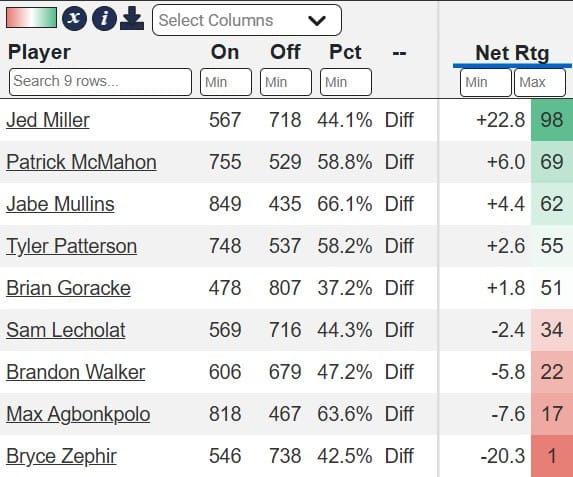
Miller obviously elevated the Bobcats every time he was on the floor as a highly impactful two-way lead guard. He is not a scorer, but he is a tremendous passer out of ball screens, deftly finding the roll man or a weakside cutter if any angle exists. He can also knock down an open jumper. Defensively, he is a scouting report-skewing menace who led the Big Sky and ranked 27th in the country in steal rate, consistently generating easy baskets in transition.
Per EvanMiya, Miller ranked 369th in the country in his all-encompassing BPR statistic. MSU’s next player landed 927th in that list. Clearly, he is a massive piece, and giving him even more minutes should benefit the Bobcats on the whole.
McMahon is the interior answer to Miller’s perimeter presence. He gives Logie a legitimate post up threat (78th percentile in efficiency as a post scorer, per Synergy) and mismatch attacker, and he flashed some potential passing upside last year as well. Both Miller and McMahon are original Montana State recruits, and that kind of internal development and continuity may matter quite a bit in a post-COVID-year era.
McMahon will anchor the interior attack, but Logie also added multiple playmakers on the perimeter to assist Miller. Logie himself hails from the Division II level, so bringing in Cavin Holden (Central Washington) and Davian Brown (Biola) makes a lot of sense. Holden is more of a pure point guard, but his dialed-in jumper should allow him to play next to Miller at times. Brown tilts more towards scorer/secondary creator who can get to the charity stripe.
Finally, Seth Amunrud was a volcanic scorer at the JUCO level (21.1ppg) who can fill it up from deep (46.8% on 158 attempts) or act as a connector/attacker (3.5apg). He could even form a terrifying defensive twosome with Miller thanks to his impressive instincts (2.8spg). He’s never played a high competition level, though, even dating back to his time as a local high school standout in Bozeman. Granted, though, his JUCO team went 29-4, so his production was not empty calories. That group will make it tough for CJ Purdie, a talented rookie combo guard, to see the floor, but he has a strong frame and pedigree (CJ McCollum’s cousin).
MSU went small to end the season last year, benching burly bruiser Brandon Walker, and that strategy proved effective. Loading up on guards (MSU also returns little-used Jeremiah Davis) to play around McMahon and a new stable of unproven big men makes sense as a result. It should also help MSU maintain a sterling assist/turnover rate, led by Miller (3.2) and McMahon (1.5).
Causes for Concerns:
Playing small to end the season worked because of the presences of Max Agbonkpolo and, to a lesser extent, Sam Lecholat and Brian Goracke. Agbonkpolo, formerly of USC, Wyoming and Utah State, was a Pac-12-caliber defender lurking in the Big Sky, a versatile 6-9 chess piece who helped Montana State lead the conference in 2P% defense.
Re-creating that kind of frontcourt impact will be difficult, even with three bites at the “P5 castoff forward” apple. None of Christian King, Chris Hodges or Waka Mbatch earned real experience before their arrivals in Bozeman, leaving their impact (and pecking order in the rotation) open to interpretation.
King has the most game experience and is the most versatile. Hodges is a veteran of the college game after spending four years at Wisconsin, but he only played 68 total minutes there. Mbatch has a high ceiling, but the Gambian native is wildly raw and will take time to make a sizable impact.
The wild card is Jaden Steppe, an invisible man at Colorado State last year but a heralded recruit from Oregon in the class of 2024. He is immensely skilled and could emerge as a real offensive weapon in Bozeman, though his defensive impact will be limited, at least early in his Bobcat career. Freshman James Steward brings defensive potential but will struggle to find minutes.
One certainty in Logie’s scheme: that group will rarely be asked to attack the offensive glass. Both of Logie’s first two Bobcat squads have ranked 357th in offensive rebound rate, per KenPom. They clearly prioritized transition defense, typically only sending one guy to the boards. That has a limiting effect on Montana State’s scoring ceiling: Despite leading the conference in turnover rate and ranking 3rd in eFG%, MSU ranked just 5th in the Big Sky in overall efficiency.
The regression monster could ambush the Bobcats on the other end. A generally conservative system did not force turnovers and did not help much off shooters (12th in defensive 3PA rate), but MSU cannot expect foes to shoot sub-30% from 3 again this year. The Bobcats ranked 11th nationally in 3P% defense, a fickle stat for all but the most elite defenses nationally.
Bottom Line:
Montana State’s regular season results under Logie have been solid but unspectacular thus far. Year 3 is when Danny Sprinkle took a major leap forward, so the Bobcats will hope to see a similar upward trendline this year. Having Miller and McMahon back as program stalwarts is a great starting point.
The upward mobility will depend on the newcomers at guard (Holden, Brown, Amunrud) and whether the assortment of down-transfer forwards can provide more of an interior presence / replace Agbonkpolo’s impact. That group is a total mystery box, but Logie is a good enough coach to extract some value from it.
8) Weber St.
Key Returners:
Viljami Vartiainen, Nigel Burris, Trevor Hennig, Declan Cutler
Key Losses:
Blaise Threatt, Miguel Tomley, Dyson Koehler, Alex Tew, Vasilije Vucinic
Key Newcomers:
Tijan Saine, Malek Gomma, Jace Whiting, Edwin Suarez
Roster:

Reasons for Optimism:
For a proud program in the Big Sky, there seems to be no direction for Weber State to go but up (hopefully). The Wildcats plummeted to ninth in the league standings last year, posting just five conference wins to go with a disappointing 12-22 overall record. They finished 300th in KenPom, the worst such ranking in the 29-year era of Ken’s website.
For some encouragement to Weber fans: this is not altogether unprecedented. Even coaching legend Randy Rahe saw some dips: his 2020 team went 12-20 and finished 273rd in KenPom, and his 2015 squad went 13-17 and landed 266th. He immediately bounced back, rolling up a 17-6 record (122nd) in COVID-shortened 2021 and a 26-9 record (142nd) in 2016. It is reasonable to hope that his protégé, Eric Duft, can exhibit the same kind of resilience and bounce back.
To do so, Weber State must rediscover some balance after a heliocentric offensive approach has led to some stumbles over the last two campaigns. Blaise Threatt was a superstar lead guard, but the supporting cast never figured out how to gel around him. Weber State also buckled badly on the defensive end for the first time since that dismal 2020 campaign.
There’s hope on both ends of the court. Tijan Saine arrives to take the point guard reins, and his impressive production at the Division II level indicates his readiness to step up in the Big Sky. A dazzling Synergy profile certainly does not hurt, either:
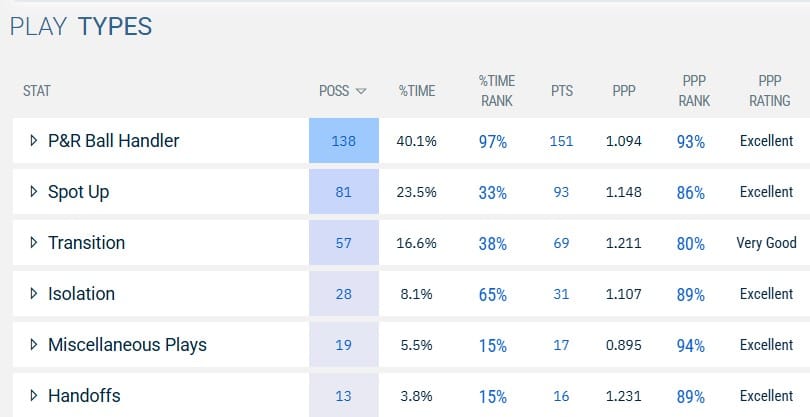
Weber State has leaned on ball screens as a primary source of offense for all three of Duft’s seasons in charge. With Saine in the picture, that likely ticks up to four straight campaigns.
Though Saine is capable as both a scorer and playmaker, he is no Threatt. That means more reps for returning starters/rotation staples Trevor Hennig (a downhill driving wing), Viljami Vartiainen (a deadeye sniper), and Nigel Burris (a physical forward with some stretchability).
Each player filled a specific role while Threatt and Miguel Tomley dominated the offense. But when Tomley had to step away from the team due to serious medical issues, both Hennig and Vartiainen found ways to amp up their contributions and create some serious optimism about their potential for this season alongside Saine.
Before Tomley’s departure, Hennig was an afterthought: 13.1mpg, 5.1ppg. In the 14 games that followed, however, he posted an efficient 11.6ppg in 32.7mpg. Vartiainen was similar, going from 6.3ppg in 21.9mpg on 35.7% 3P shooting to 12.8ppg in 30.4mpg on 45.2% from 3. That, folks, is reason for optimism!
The perimeter group is even stronger with the addition of Jace Whiting, a sharpshooter with copious Mountain West experience (he was a key bench piece for Boise State in 2023 and 2024). Duft also swiped Malek Gomma, a powerful 245-pound interior piece, from WCC-bound Seattle. Gomma fills a key role as a voracious two-way rebounder, an aggressive finisher, and a stout defensive presence.
Causes for Concerns:
The handoff from Rahe to Duft was supposed to be a smooth one. Duft had been on staff at Weber State since 2006, Rahe’s trusted confidante and a key part of Weber’s decades of winning basketball. The slippage last year – though not unprecedented, as mentioned – is a warning sign.
Some question marks are especially warranted because last year’s team had a legitimate star in Blaise Threatt. Duft had an NBA player in 2024 in Dillon Jones and mustered just an 11-7 Big Sky record, and then last year’s tumble while Threatt dominated creates real concern.
The veteran guard was top 50 nationally in usage and ranked 61st in assist rate, evidencing his do-it-all game and immense offensive burden. He rarely left the court last year, and his gargantuan (and efficient) production will be a nightmare to replace.
Defense is also an extreme concern. That is not Vartiainen or Hennig’s forte, and in the 438 minutes where that duo shared the court, Weber State posted a terrifying 117.2 defensive rating, per CBB Analytics (8th percentile). Throw in Burris as well, and it crept up to 118.6 in 253 minutes. Adding Whiting will do little to stem the tide there, and neither Gomma nor Declan Cutler is an eraser at the rim.
That means Weber State needs some help from Edwin Suarez and a merry band of brave new freshmen. Suarez, a junior college transfer, is a ‘tweener forward type who excels on the glass. David Hansen is the lone redshirt freshman, and he will battle Cutler for frontcourt minutes. That rotation could get additional athletic juice from Bourgeois Tshilobo, a rim-gobbling rookie.
If any of the freshman perimeter trio of ArDarius Grayson, Duce Paschal and Anthony Moore show real stopper potential, then he will see the floor right away. With Saine, Hennig, Vartiainen and Whiting, the Wildcats have a bevy of backcourt bombers. But the newcomers can really make their mark with contributions in other parts of the game. Moore is my bet of the bunch, but any of the three could seize real playing time.
Bottom Line:
This is a serious “prove it” season for Duft. Has Weber State lost its way a little bit after a disastrous 2024-25? Or was that, like multiple times during Rahe’s tenure, a stumble in the midst of a furiously quick rebuild? Time will tell, but the Wildcats must do it without their super star Threatt setting the tone.
Saine has the ability to be a stellar on-ball replacement, while the offense should fire with Vartiainen and Whiting knocking down 3s and Hennig getting to the rim. The season hinges on whether Duft and Weber State can build a competent defense, and that could be a challenge with this roster. Overall, WSU may still have an uphill battle to resurface near the top of Big Sky.
9) Sacramento St.
Key Returners:
None
Key Losses:
Everyone
Key Newcomers:
Mikey Williams, Bear Cherry, Shaqir O’Neal, Prophet Johnson, Jahni Summers, Brandon Gardner, Taj Glover, Jayden Teat, Zach Anderson, Jeremiah Nyarko, Romari Robinson
Roster:

Reasons for Optimism:
If new energy is a reason for optimism (and generally, I think it is), then Sacramento State has plenty. The Hornets zagged in a stunningly severe way this offseason, hiring former Sacramento King great Mike Bibby – he of absolutely zero Division I coaching experience – to put a jolt through the program and the city. Bibby doubled down on that excitement by pinpointing none other than Shaq to be his program’s General Manager (surely a very active scouting role).
The associated excitement around those hires helped Sacramento State secure some talented (if mercurial) transfers that put the Hornets’ roster in the upper echelon of the league, on paper. Translating that pedigree and potential into wins falls to Bibby & Co., but they have at least given themselves the upside to quickly climb the Big Sky ladder.
Given his background and the chatter around the program, Bibby seems likely to go heavy pro-style on offense. That means up-tempo when possible, pressing on defense to ratchet up the pace, and playing out of spread ball screens in the half court. The Hornets’ PnR tandem of Mikey Williams and Bear Cherry should, at least in theory, be a major strength of the team.
Williams is an immense piece for this league, a skilled and smooth operator on the ball who should excel now that he’s back to being The Guy (he struggled as a bit piece for UCF). He’s long and strong on the ball, showing solid passing vision and a mind for scoring. If he does struggle, Bibby brought in a terrific insurance policy in Prophet Johnson, a crafty on-ball operator in the MAAC who posted a crisp 2.26 assist/turnover ratio (91st percentile nationally) while also being one of the best rebounding guards in the country.
Whether it is Williams or Johnson handling the rock, their ball screen partner, Cherry, is an ox and will consistently overwhelm Big Sky frontcourts with his bludgeoning size. After doing that to Mountain West bigs, he profiles as one of the most dominant players in the conference. He did not serve as a roll man often at UNLV, but he scored in the 93rd percentile of efficiency when he did, per Synergy. That should strike fear into Big Sky opposition. Jeremiah Nyarko gives the Hornets an acceptable depth piece behind Cherry, but the big man will play as many minutes as he can handle at Sac State’s pace.
Cherry could also give the Hornets a go-to interior threat. He ranked in the 100th percentile in post up frequency, per Synergy, and landed in the 72nd percentile of efficiency (again, versus a much more rugged/bigger league). Whether Bibby fully takes advantage of this kind of asset remains to be seen, but Cherry gives him a nearly unfair weapon.
Sac State’s great gamble is on Brandon Gardner, a highly talented ‘tweener forward type who could be a mismatch destroyer in this conference. He was unable to make an impact at either USC or Arizona State, but if Bibby can get him on the court consistently, a standout year like well-traveled top recruit Marcus Adams had at CSUN is not out of the question (well, a watered-down version of his 16ppg, 5rpg, 1.5apg on efficient shooting).
Causes for Concerns:
Call me crazy, but extremely loud alarm bells go off in my head when a team hires a coach who hasn’t, you know, actually coached since 2019-20. He lasted 10 games at Hillcrest Prep in Phoenix before mutually parting ways with the school in the middle of the season. That does not give me strong “this guy loves the job” vibes!
You’d expect his staff to be full of seasoned coaching veterans, particularly from the college ranks. Instead, he hired his son, Michael Bibby, a young former assistant of his father’s with seemingly zero college coaching experience, as his associate head coach. The rest of the staff consists of an AAU coach/trainer (Raymond Walcott), a high school/G-League coach (Jason Fraser), another high school coach (Greg Moody II), and a high school and AAU coach/scout (Dr. August Mendes). Not many warm and fuzzies for me there.
On the court, a key part of a spread ball screen attack is actually being able to spread the floor. The Hornets seem low on shooting outside of Jahni Summers (likely a positive piece there) and Arman Madi (far more TBD as a recycled Big Sky fringe piece). Williams bricked away at UCF in his bench role, and Johnson is decidedly not a shooting threat. Shaqir O’Neal is not going to actually worry most opponents as a stretch 4, and Gardner and freshman Mark Lavrenov are TBD in that role.
That puts some onus on the bench’s two transfer unknowns, Jayden Teat and LaTaj Glover, to live up to the hype of their previous programs. Filling out the bench with guys from Utah and South Florida is a rare luxury in the Big Sky, but neither made a dent at those stops. Teat is a Sacramento native who could see a boost with his return home. Bibby also reached all the way to Miami, Florida, to snag freshman Romari Robinson, a bigger guard with potential to blossom in Sacramento.
Finding out how Bibby plans to defend – and whether this roster fits his vision – is also an open question. He sounds like he wants to fly around and pressure, which would require athletic depth to sustain (ask Portland State). This roster has both depth and athleticism in theory, but whether the players can be disruptive enough to avoid becoming a layup line is a real concern. Cherry’s size allows him to be a true rim protector, but he’s not overly mobile and could struggle with conditioning if Bibby really wants to play at a turbo clip.
Bottom Line:
The lab experiment that is Sacramento State should be fascinating to watch. Can a staff with essentially zero college coaching experience, including a head coach who has not actually coached in almost six years, really maximize this roster and compete in the Big Sky? Or will this be a horrible flameout while trying to draw external attention to the program? For an even deeper dive on the Hornets’ potential style, check out our own Jordan Majewski’s deep dive.
My best guess on the outcome here: both, on various nights. The talent can play up when it’s all dialed in together, and Sac State could be a tough out in buy games. But I fully expect some mystifyingly bad performances where Williams and Gardner fight over the ball, Cherry only plays 15 minutes for some unknown reason, and Sac State’s defensive pressure gets shredded. Climb aboard the roller coaster, strap in, and keep your hands and arms inside the vehicle.
10) Northern Arizona
Key Returners:
Diego Campisano, Oakland Fort, Ryan Abelman, Leigh Rickwood-Pitt
Key Losses:
Trent McLaughlin, Jayden Jackson, Carson Towt, Monty Bowser, Dillan Baker
Key Newcomers:
Arne Osojnik, Isaiah Shaw, Karl Markus Poom, Kavon Bradford, Erez Poran, Walker Timme, Traivar Jackson, Zack Davidson
Roster:

Reasons for Optimism:
NAU’s 2024-25 season hit a major snag before it even started. After all of the offseason’s roster movement, the team found out Carson Basham was academically ineligible for the season, a gutting twist to a team that ran a huge chunk of its offense through him back in 2023-24. That left Coach Shane Burcar to pick up the pieces without any hope of finding an adequate replacement.
Given that context, NAU’s season – 18-16 overall, 8-10 in the league, the program’s third-highest KenPom finish in the last decade – is a relative success. The Lumberjacks had significantly higher hopes, though, and Burcar now has a tough task on his hands following a major roster exodus.
Fortunately, NAU has a group of veteran guards that are accustomed to playing with each other, and Burcar searched far and wide in the portal – from Buffalo to San Francisco – to fill out the rest of the squad. The Lumberjacks lack last year’s high-level continuity, but with *knock on wood* no late personnel attrition, they could rally for a better season.
The Lumberjacks’ system should revolve around the trio of Oakland Fort, Diego Campisano, and Ryan Abelman. Fort will handle the ball, and though he slumped his way out of the starting group last year, he started 32 of 33 games in 2023-24. He’s lightning-quick and will be tasked with setting the table for Campisano, a prolific and versatile wing scorer, and Abelman, a lower-usage (but efficient) catch-and-shoot piece.
All three members of that group have had stretches – albeit brief, for Campisano and Abelman – of significant productivity in Flagstaff:

They need to find more consistency, but the flashes display the possibilities with that trio under Burcar’s tenure.
NAU smartly filled out the perimeter rotation beyond that group, as well. Arne Osojnik is the standout, a productive floor spacer who can play on the wing or occasionally slide down to a smallball 4 role. The Slovenian had two impressive years in the MAC, knocking down shots and disrupting things as a defender. His shot breakdown so far in his career – 301 3s, 150 2s, 43 FTs – perfectly demonstrates the kind of player he is.
Beyond that, Burcar gambled on upside with Kavon Bradford, a rising sophomore point guard who was in basketball Siberia at Buffalo last year, and Traivar Jackson, who journeys north after riding the bench at Grand Canyon. Bradford has some upside if he can correct the, um, “youthful exuberance in his decision-making, while Jackson was a useful ‘tweener type for Tarleton State back in 2023-24. His athleticism as an undersized 4 could be a welcome complement to NAU’s perimeter skill. Erez Poran is probably more of a long-term addition, but the Israeli wing could crack the rotation.
Causes for Concerns:
In six years, Burcar has not finished above .500 in the league. He is 29-59 in Big Sky play over the last five years. NAU is a tough place to win, but if it did not happen for Burcar with an elite scorer (McLaughlin), an elite rebounder (Towt) and a wealth of experience (86th nationally per KenPom) and continuity (64th), is it ever actually going to happen? Mustering optimism over the program’s current direction is difficult based on recent results.
On the court, the Lumberjacks appear to have a significant void inside. Burcar has frequently played through the post, ranking in the top 30 in Post Up rate in each of the last three seasons per Synergy. After Basham was ruled ineligible, Carson Towt emerged as a strong interior facilitator, but he transferred to Notre Dame this offseason. He may have to shift away from that approach given the remaining personnel.
Leigh Rickwood-Pitt is a thin Australian who struggled to impact the game in his first Division I season. He had just five assists all season and was purely a play finisher. That puts a heavy onus on the incoming frontcourt pieces: Walker Timme (college hoop fans might recognize that last name), Isaiah Shaw, Zack Davidson and Karl Markus Poom.
Timme can be a contributor around the rim, but he is not is brother and has not shown the requisite passing chops. Similarly, Shaw was mostly a spot up guy at Valpo, a true “stretch 4” type who does not create for others and is mostly a bigger, worse version of Osojnik. Davidson arrives from league rival Montana Poom is the lottery ticket, an Estonian forward who sat behind a talented San Francisco frontcourt but flashed supreme potential while representing his country in FIBA EuroBasket events. If NAU is lucky, he could be Towt Lite, a force on the boards who can also facilitate offense. Jackson may also get a crack at triggering the Lumberjacks’ attack.
Towt’s departure, plus the graduation of Trent McLaughlin, one of the nation’s leading scorers, robs NAU of two of its biggest strengths. Burcar’s defensive scheme emphasizes cleaning the defensive glass, and Towt was one of the mega-elite defensive rebounders in the country. He ranked 2nd in D-Reb rate per KenPom, helping NAU land 7th nationally in that category as a team. The remaining roster will suffer without his presence, even if Poom reaches his potential.
McLaughlin, meanwhile, lit up the scoreboard from everywhere on the court while posting a strong 1.92 assist/turnover ratio. Fort, Bradford and the rest of NAU’s ball-handlers have to replace that efficient scoring by committee, or NAU’s 44th-ranked turnover rate will fall markedly.
Bottom Line:
Last year was the one to circle for NAU. The Lumberjacks returned a ton from an upswinging squad in 2024, setting the table for a special push. But the late loss of Basham derailed that momentum, leaving NAU to scrap away in the middle of the Big Sky table. Even outstanding years from McLaughlin and Towt were not enough to raise the Lumberjacks’ ceiling.
Burcar’s initial five-year contract expired in March. I could not find any reporting on an extension beyond that, but he is back for this year. Does he have enough in the arsenal to stave off the hot seat again? It would take a special effort from a nondescript roster, but crazier things happen all the time in this sport.

